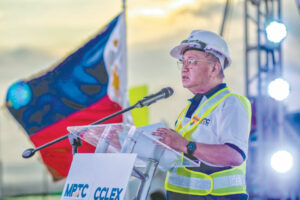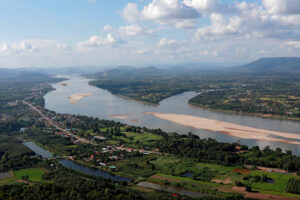Visayas’ express link to economic growth

After three years, Cebu has a new road that is expected to make the province more connected as well as help boost its economic activity as the Cebu-Cordova Link Expressway (CCLEX), the first toll expressway in the Visayas region, ceremonially opens today, April 27.
The 8.9-kilometer (km) toll bridge, which costs P33 billion to build, links mainland Cebu in Cebu City to Mactan Island through the coastal municipality of Cordova. Estimated to benefit 50,000 vehicles daily, the expressway is seen to ease the traffic on the existing Marcelo Fernan Bridge and the Mandaue-Mactan Bridge.
CCLEX has two lanes in each direction and also features the main navigation span twin-pylon cable-stayed bridge, viaduct approach bridges on Cebu City and Cordova sides, Cebu South Coastal Road on- and off-ramps, a causeway, and a toll plaza.
Further highlighting the expressway are eight 40-meter crosses on top of the pylons, designed to symbolize Cebu’s significant role as the cradle of Catholic devotion. The crosses were lit up in April 15 last year, in time with the celebration of the 500th anniversary of Christianity in the country.
The bridge has a design speed of 60 to 80 kilometers per hour, and a 52-meter height or navigational clearance to allow large vessels to pass underneath. It can also withstand up to magnitude 10 earthquake and is vessel-collision proof.
A major construction milestone that closes the gap between Cebu City and Cordova is CCLEX’s main bridge, which was completed last Oct. 5. The main bridge, spanning almost 2.8 k.m., consists of the main bridge structure (653 m), the Cebu South Coastal Road on- and off-ramps (779 m), the Cebu Viaduct (432.80 m), and the Cordova Viaduct (917.30 m). Its two main bridge towers, meanwhile, are 145 m tall.
CCLEX’s main bridge is fitted with several state-of-the art equipment, such as a Road Weather Information System that provides weather watches and warning for public safety; stay cable accelerometers to monitor stay cable movements; GPS geometric controls at the two towers; and expansion joint movement sensors.
“We have finally reached the epic milestone of the CCLEX construction project, which truly lives up to the expressed view of builders and development leaders that CCLEX is truly an ‘engineering marvel,” MPTC President and CEO Rodrigo E. Franco said in a statement last year. “It gives me and my corporate and government colleagues a deep sense of pride and accomplishment for this region and the entire country,” he said.
CCLEX’s other features include 56 installed stay cables, a 200-meter pedestrian footbridge, as well as four low-level bridges for fishermen and 20 vent pipes for water channel equalization at the Cordova side.
The CCLEX will be using a full electronic toll collection system, powered by radio-frequency identification (RFID), for more efficient lane throughput. RFID installation has been ongoing as early as December last year.
Other features that ensure safe and convenient travel for motorists include weigh-in-motion sensors for detecting overloaded vehicles and IP-based speed detection cameras and high-definition closed-circuit television systems for traffic monitoring and incident detection.
The expressway will also have service facilities such as gasoline stations, retail outlets, convenience stores, restaurants, as well as security, medical, and maintenance centers that will address the needs of every motorist who passes through the toll road.
Metro Pacific Tollways Corp. (MPTC) Chairman Manuel “Manny” V. Pangilinan delivers a speech during an event marking the main bridge deck connection of the Cebu-Cordova Link Expressway in November 2021.
The Cebu Cordova Link Expressway Corp. (CCLEC), a subsidiary of Metro Pacific Tollways Corp. (MPTC), built, operates, and maintains CCLEX under a joint venture agreement with the local governments of Cebu City and Cordova. This makes the expressway MPTC’s first expressway project outside Luzon.
CCLEC has selected a multi-disciplined technical team for the project. Back in November 2017, CCLEC issued the notice of award for the “Build and Design” contract of CCLEX to Cebu Link Joint Venture (CLJV), a consortium of Spain-based infrastructure leader Acciona Construccion S.A. and Filipino companies First Balfour, Inc. and D. M. Consunji, Inc. The contract was signed the following December.
CCLEC also engaged the services of COWI A/S of Denmark with the Philippines’ DCCD Engineering Corp., as its sub-consultant, to be the project’s technical advisor/owner’s engineer. Norconsult, a Norwegian consultancy firm, was also tapped as the project’s independent consultant.
CCLEC secured a P19-billion syndicated loan facility to bankroll the project. In February 2019, CCLEC inked a 15-year omnibus loan and security agreement with the Rizal Commercial Banking Corp., Development Bank of the Philippines, Robinsons Bank Corp., Union Bank of the Philippines, Bank of the Philippine Islands, and Security Bank Corp. The remaining funding requirements for the project are shouldered by the project company.
New path for development, investment boost
Aside from beefing up the road network of Cebu, CCLEX is eyed to spur economic growth and boost investments not just in Cebu City and Cordova, but also in the entire Cebu province and Visayas region. During the main bridge deck connection ceremony last October, Felix Taguiam, immediate past president of the Cebu Chamber of Commerce and Industry, noted that the bridge is set to open up the region to new developments.
“With Cebu City and Cordova connected, we will see the enhancement of trade, tourism, and business. Communities on each side of the border will then know one another better and be able to help one another grow and prosper through trade and development,” Mr. Taguiam said.
For Cordova Mayor Mary Therese Sitoy-Cho, the expressway has the potential to boost the current municipality and transform it into a city in the near future. “Linking Cordova to the highly urbanized Cebu City brings the inevitable economic development to our small, dynamic town. It has been my father’s dream for Cordova to become a city and I believe that with this bridge, this is bound to happen in the next few years,” Ms. Sitoy-Cho said.
In addition to easing up the mobility of people and goods within Cebu’s traffic-congested metropolis, CCLEX also aims to improve access to the redeveloped Mactan-Cebu International Airport, as well as provide a faster connection from Mactan Island to mainland Cebu for business travelers and tourists alike.
The expressway is also seen to be sustaining investor interest in Cebu, which is one of the country’s various economic hubs outside Luzon and is the second-most populous province in the country next to Metro Manila.
Notably, more investments within Cebu have been pouring in from the country’s largest corporations. Ayala Corp. and SM Prime Holdings, Inc., for instance, have joined forces for the establishment of a 16,000-seater convention center in South Road Properties. Ayala Group’s property arm Ayala Land Inc., meanwhile, also introduced a prime commercial project called District Square that will be located within the seaside South Coast City on Cebu City’s South Coastal Road.
Also, the Gokongwei Group, which traces its roots to Cebu, puts up a gaming business in Cebu with the NUSTAR Resort and Casino. Developed by Universal Hotels and Resorts Inc., NUSTAR is located at Kawit Point at South Road Properties in Cebu City. Considered first and biggest of its kind outside Metro Manila, it will have a gaming facility with a gross floor area of 21,000 square meters, numerous spaces for luxury retail and dining, a convention center that can accommodate 2,000 participants, plus three hotel towers with over 1,000 rooms. In addition, Robinsons Land Corp. has several office and residential developments in Cebu. — Adrian Paul B. Conoza




